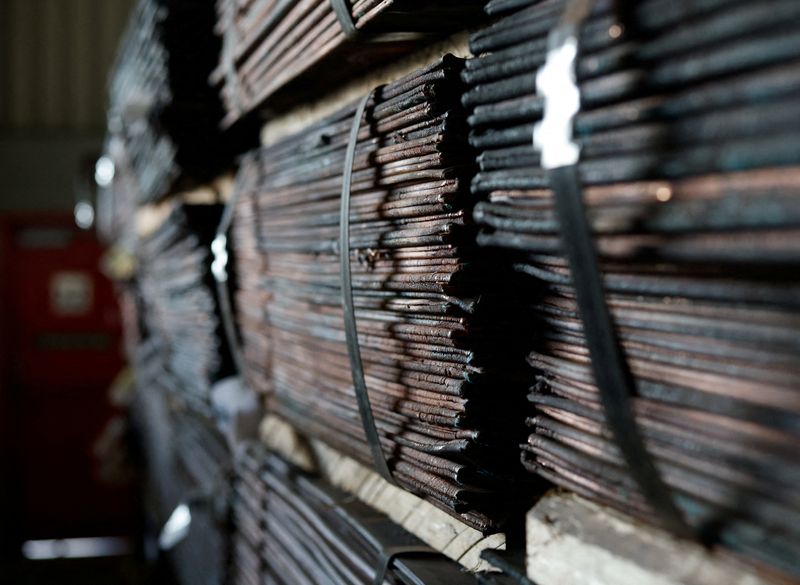Commodities
Physical buyers win battle for copper market as funds retreat

By Pratima Desai
LONDON (Reuters) – Investors fleeing the market are likely to be sidelined for many months, leaving the field clear for physical players who expect demand in top consumer China and elsewhere to deteriorate over coming months and weigh on prices.
A fund buying frenzy, based on an expected shortage of copper relative to demand, sparked a rally on the London Metal Exchange (LME) earlier this year, which quickened as momentum traders entered the fray to lift prices to a record high above $11,100 a metric ton in May.
At the same time, commodity traders were buying on the LME to deliver against their commitments to sell copper on COMEX, part of CME Group (NASDAQ:).
However, copper has dropped nearly 20% since as persistently weak manufacturing activity led the physical market to reassert control, with consumers putting purchases on hold and producers and traders delivering surplus metal to LME-registered warehouses.
“Updates to demand and refined production have pushed the market to a surplus sooner than expected,” said Macquarie analyst Alice Fox, who expects copper surpluses of 265,000 metric tons this year, 305,000 tons in 2025 and 436,000 in 2026.
Fox said prices may recover in the fourth quarter if exchange stocks are drawn down.
“However, absent faster global growth boosting demand, the more sizeable surpluses in 2025 and 2026 mean this rally is likely to be short-lived,” Fox said, adding that prices could fall back towards $8,000.
BURNT FINGERS
LME copper hit 4-1/2 month lows of $8,714 a ton in early August as U.S. recession fears and concern the Federal Reserve has kept interest rates too high exacerbated negative sentiment from soaring inventories and lacklustre demand.
China consumes more than half of global refined copper supplies, estimated at around 26 million tons this year.
But much of the copper used in China is for wiring in household goods which are then exported. A housing market slump and China’s stagnant manufacturing sector highlight the headwinds copper demand faces.
“If you strip out exports, domestic demand in China looks to be anaemic. There’s no copper shortage,” said BNP Paribas (OTC:) analyst David Wilson, who expects a surplus of between 150,000 and 200,000 tons this year.
“Product fabricators have destocked. If you are a manufacturer and unsure about the outlook for demand and exports, you are not going to restock aggressively.”
Data from the International Copper Study Group (ICSG) showed a copper market surplus of 416,000 tons between January and May, laying bare the idea of large deficits this year.
Copper inventories in warehouses registered with the LME, a market of last resort, have risen to five-year highs above 300,000 tons, up around 200% since mid-May.
Most of the metal was delivered to LME warehouses in Korea and Taiwan. It came from Chinese producers unable to sell their wares to the domestic market and aiming to take advantage of LME prices above those on the Shanghai Futures Exchange.
Copper stocks in the South Korean cities of Busan and Gwangyang and Taiwan’s Kaohsiung totalling 239,100 tons now comprise 78% of total copper stocks in the LME system compared with 31,925 tons and 31% on May 16.
The threat of a prolonged strike at BHP’s Escondida copper mine in Chile, which produced nearly 5% of the world’s copper in 2023, raised concerns last week about tighter supplies but a settlement on Sunday dispelled the fears.

Over the longer term however, deficits are predicted as structural changes to copper consumption from new technologies linked to AI and the energy transition accelerate.
“We still see copper as the backbone for decarbonisation,” said Glencore (OTC:) CEO Gary Nagle at a recent briefing. “Spending on AI data centres, renewable infrastructure is very copper hungry, very copper intensive.”
Commodities
Oil prices rise; U.S. crude inventories plunge, Russia-Ukraine truce eyed
Commodities
India’s Reliance to stop buying Venezuelan oil over US tariffs, sources say
Commodities
Oil prices climb on Venezuela supply worries

 Forex3 years ago
Forex3 years agoForex Today: the dollar is gaining strength amid gloomy sentiment at the start of the Fed’s week

 Forex3 years ago
Forex3 years agoUnbiased review of Pocket Option broker

 Forex3 years ago
Forex3 years agoDollar to pound sterling exchange rate today: Pound plummeted to its lowest since 1985

 Forex3 years ago
Forex3 years agoHow is the Australian dollar doing today?

 Cryptocurrency3 years ago
Cryptocurrency3 years agoWhat happened in the crypto market – current events today

 World3 years ago
World3 years agoWhy are modern video games an art form?

 Commodities3 years ago
Commodities3 years agoCopper continues to fall in price on expectations of lower demand in China

 Economy3 years ago
Economy3 years agoCrude oil tankers double in price due to EU anti-Russian sanctions



























